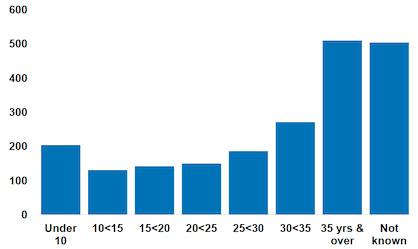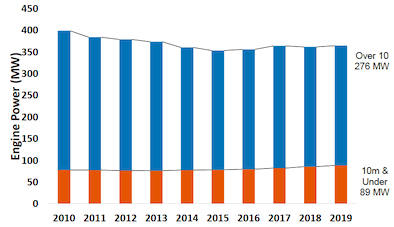Scottish Sea Fisheries Statistics 2019
National Statistics publication that provides data on the tonnage and value of all landings of sea fish and shellfish by Scottish vessels, all landings into Scotland, the rest of the UK and abroad, and the size and structure of the Scottish fishing fleet and employment on Scottish vessels.
4. The Scottish fishing fleet
4.1. Regulation of the UK fleet
UK fishing vessels are required by law to be registered with the Registry of Shipping and Seamen (RSS), part of the Maritime and Coastguard Agency. Fishing vessels must also have a licence that specifies conditions that must be adhered to. For the purpose of this publication, active vessels are those that are both registered and licensed as at 31st December of that year. Scottish based vessels are those registered to a port in Scotland licensed and administered by a Scottish district (see the map). UK fishing vessel licences authorise the sea areas in which a vessel can fish and the species of fish that can be caught.
The capacity of fishing vessels in terms of vessel tonnage and engine power is also controlled through licences. With a finite number of licences in existence and no new licences made available, this places a ceiling on the total number and capacity of vessels in the UK fishing fleet. In order to licence new vessels, fishers must acquire existing licences from other previously licensed vessels.
4.2. The Scottish fishing fleet
The number of active Scottish based vessels has increased to 2,098 vessels in 2019, an increase of 9 vessels since 2018 and a two per cent decrease (44 vessels) since 2010 (Table 35). The Scottish fleet is dominated by vessels that are ten metres and under in length with a total of 1,559 vessels falling into this category in 2019, accounting for 74 per cent of the Scottish fleet. 539 vessels are over ten metres in length.
Compared to 2010, the ten metre and under fleet has increased by 80 vessels (five per cent) while the over ten metre fleet has decreased by 124 vessels (19 per cent).
Around one quarter of vessels (24 per cent, 504 vessels) in the Scottish fleet are of unknown age. Of those that are known, 477 (30 per cent) are under 20 years old, with an overall average age of 28 years (Table 36 and Chart 10).

Table 37 shows the number of vessels in each of the eighteen administration districts in Scotland. Fraserburgh is the district with the highest number of vessels with 223 vessels (11 per cent of the Scottish fleet) . This was closely followed by Shetland (221) and Stornoway (219) districts. A little over half (56 per cent) of the vessels in the Fraserburgh district were in the ten metre and under category, whereas for Stornoway and Shetland districts this was just over four-fifths of the vessels there. Lochinver is the only district to have more over ten metre vessels (64 per cent) than ten metre and under vessels. In the over ten metre fleet, there are more vessels targeting shellfish on the West coast than in the islands or East coast, whereas demersal and pelagic vessels are concentrated on the East coast.
The total engine power of the Scottish fleet has remained broadly consistent at 365 thousand kW (up 2,707 kW, one per cent change since 2018). The total power of the over ten metre fleet remained stable at 276 thousand kW and the total power of the ten metre and under fleet increased three per cent to 89 thousand kW (Chart 11). The average power for the over ten metre fleet was 512 kW per vessel in 2019, whereas the ten metre and under vessels had an average power of 57 kW per vessel.
Compared to 2010, average power has seen change in the ten metre and under fleet and the over ten metre fleet, with an increase of seven per cent in the ten metre and under fleet and an increase of six per cent in the over 10m fleet.

Contact
Email: fisheriesstatistics@gov.scot
There is a problem
Thanks for your feedback